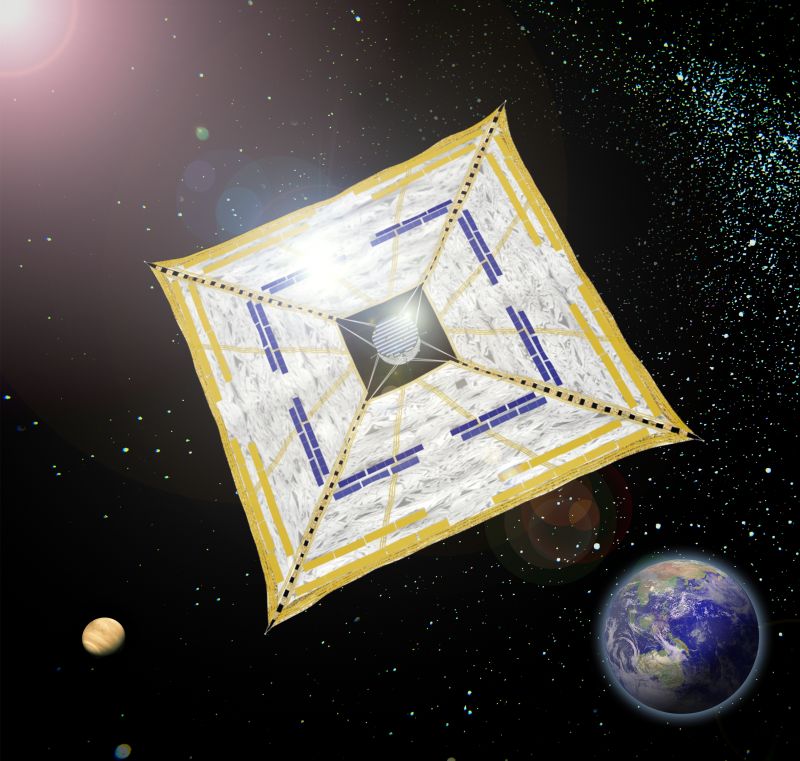 IKAROS – Japan’s Solar Sail
IKAROS – Japan’s Solar Sail
What you need to know: Japan is launching two satellites on May 18th, 2010, one towards Venus and the other, IKAROS, to demonstrate the tranquil and romanticized method of interplanetary travel: the solar sail. A solar sail is unpowered, the spacecraft pushed by the force of the solar radiation. A solar power sail combines thin solar panels with the sail for on board power.
Edit 5/17 5pm PST: Launch scrubbed due to weather. The window is open until June 3, other wise Junya Terazono suggests that it may be launched in May 2011. No official word on any of that yet though.
Emily on Twitter
Edit 5/17 11:45pm PST: Launch rescheduled to May 21 6:58 (Japan time).
The JAXA/Akatsuki Twitter account (you might need THIS)
Edit 5/22 IKAROS launched successfully and powered up!
Solar Sails
Sounds like science fiction, but a solar sail is pushed by the photons from the Sun. That’s right, you’re using sunlight to sail, not the solar wind. The Planetary Society has a full explanation, but when a photon is reflected it exerts a small force on the surface reflecting it. The Sun certainly generates a lot of photons, so if you have a large, lightweight, reflective surface, it will be pushed by the force of many photons being reflected off it. Just like a sailboat, the larger your sail the more wind (or in this case reflected photons) you can catch.
And therein lies the problem. Photons are very small. Very, very small. Imagine an regular ant trying to push a semi-truck. Not gonna work – though in a perfect situation there would be some small effect. How many ants do you think you would need? Would all those ants be able to push on the truck or would there be too many of them? A solar sail needs to be huge, and extremely lightweight.
IKAROS
JAXA and The Planetary Society are both done with solar sails being relegated to science fiction just because of the technical challenges. JAXA’s decided to combine a solar sail with solar in order to demonstrate some of the possibilities awaiting us. Their “sail” is covered in solar panels, so in addition to being pushed by the light from the Sun they’ll be generating power. The main mission objectives: prove that a spacecraft can be propelled by a solar sail, and prove that the thin solar panel membranes they’ve chosen do generate power.
Ikaros will unfurl its sail by spinning. You can see this in their video, the spinning starts around 06:50. The video is in Japanese, but you don’t need to understand what they’re saying to want an umbrella that works this way!
Daedalus and Icarus
Daedalus was imprisoned in a tower with his son Icarus, so he built a pair of wings for each of them. The feathers were fastened to the frame with wax, so Daedalus warned his son not to fly too close to the Sun. Of course, being a young boy Icarus ignored his father. He flew so high the wax melted, the wings broke, and he tumbled to his death in the raging sea below. Daedalus escaped successfully and lived safely for a while after that.
That’s the myth as I’ve heard it – I think I’d prefer to name my test mission after Daedalus.
Questions I had after reading about IKAROS:
- Does IKAROS have an ion engine? No, that’s an application of combining solar sails with other propulsion that JAXA’s website proposes.
- Is IKAROS going to Venus? Well, it’ll be on a trajectory towards Venus, but it won’t be able to do orbit insertion so it will just do a far-away fly-by.
Want More?
IKAROS at JAXA
JAXA (the Japanese Space Agency)
The Planetary Society’s Light Sail
![]()
~ A l i c e !








Hello, really good entry, I was always wondering if it is real. Finally I know it, thanks to you :) PS Really nice blog template is it “homemade” or free? :D